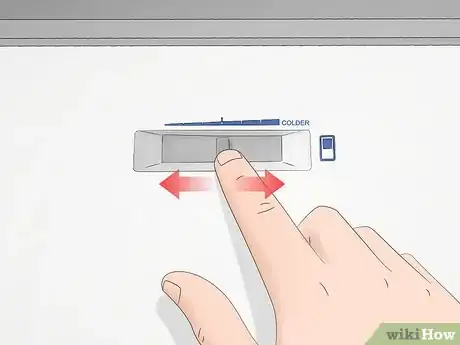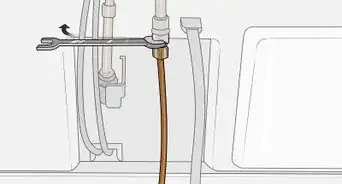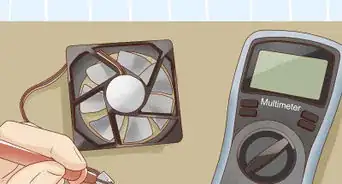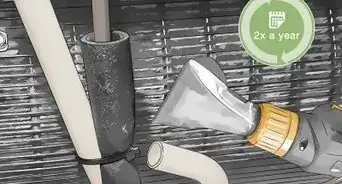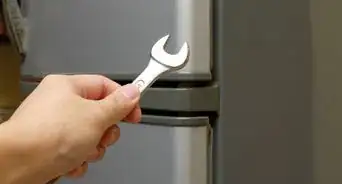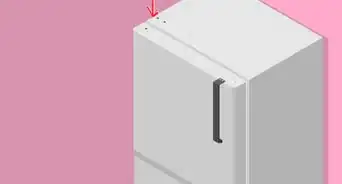This article was co-authored by Aaron Beth and by wikiHow staff writer, Hunter Rising. Aaron Beth is the founder of Aaron’s Refrigeration Company in New York City and a factory certified installer (FCI) for Sub-Zero products. He specializes in the service and maintenance of built-in refrigerators, wine coolers and ice machines. With over 54 years of experience, Aaron is the recipient of numerous Super-Service awards from Angie’s Lists and 2019 Best-of-the City.
There are 16 references cited in this article, which can be found at the bottom of the page.
This article has been viewed 429,987 times.
Have you noticed that the food in your fridge is spoiling faster than usual? When your fridge runs a little too warm, food might not stay fresh and it could lead to bacteria growth. Luckily, setting your fridge thermostat to the perfect temperature is really easy and only takes a few seconds. While the way you adjust your fridge temperature is different between models, they still operate pretty similarly. We’ve got everything you need to know about common thermostat adjustments, ideal temperatures, and tips for keeping your fridge cold.
Things You Should Know
- If your fridge has a dial thermostat, turn it to the “colder” setting or to a higher number to bring the temperature down.
- For a sliding gauge thermostat, push the slider to the right to make your fridge cooler.
- If your fridge has a digital display or keypad, press the “Temperature” button. Use the up and down arrow buttons to change the temperature.
- Keep your fridge below 40 °F (4 °C) and your freezer around 0 °F (−18 °C).
Steps
Measuring Refrigerator Temperature
-
1Place a fridge thermometer on the middle shelf. Try to center the thermometer in the refrigerator as much as possible since that’s where you’ll get the most accurate reading. Some fridge thermometers are free-standing, while others you can hang from the shelf.[6]
- If you're using a stick-shaped thermometer, keep it in your fridge submerged in a glass of water.
- The warmest spot in your fridge is usually closer to the door, so it’s also a good alternative place to put your thermometer.[7]
-
2Check the temperature after 5–8 hours. Your thermometer needs a little bit of time to adjust to the proper reading for your fridge. Try to keep the door closed as much as possible so the temperature stays consistent. Once enough time passes, check the reading on your thermometer to get an idea of your fridge’s average temperature.[8]
- If you adjust your fridge temperature, it may take a full 24 hours to fully adjust. Check the thermometer again the next day to see if there are any changes.
- Check up your fridge thermometer about once a week to track any changes to the refrigerator temperature.[9]
- It may take a full day to track any changes in temperature after you adjust your fridge thermostat.
Expert Q&A
Did you know you can get premium answers for this article?
Unlock premium answers by supporting wikiHow
-
QuestionWhat should I do if my fridge is hot?
 Aaron BethAaron Beth is the founder of Aaron’s Refrigeration Company in New York City and a factory certified installer (FCI) for Sub-Zero products. He specializes in the service and maintenance of built-in refrigerators, wine coolers and ice machines. With over 54 years of experience, Aaron is the recipient of numerous Super-Service awards from Angie’s Lists and 2019 Best-of-the City.
Aaron BethAaron Beth is the founder of Aaron’s Refrigeration Company in New York City and a factory certified installer (FCI) for Sub-Zero products. He specializes in the service and maintenance of built-in refrigerators, wine coolers and ice machines. With over 54 years of experience, Aaron is the recipient of numerous Super-Service awards from Angie’s Lists and 2019 Best-of-the City.
Refrigerator Technician
-
QuestionHow does a fridge temperature control work?
 Aaron BethAaron Beth is the founder of Aaron’s Refrigeration Company in New York City and a factory certified installer (FCI) for Sub-Zero products. He specializes in the service and maintenance of built-in refrigerators, wine coolers and ice machines. With over 54 years of experience, Aaron is the recipient of numerous Super-Service awards from Angie’s Lists and 2019 Best-of-the City.
Aaron BethAaron Beth is the founder of Aaron’s Refrigeration Company in New York City and a factory certified installer (FCI) for Sub-Zero products. He specializes in the service and maintenance of built-in refrigerators, wine coolers and ice machines. With over 54 years of experience, Aaron is the recipient of numerous Super-Service awards from Angie’s Lists and 2019 Best-of-the City.
Refrigerator Technician
-
QuestionHow do I adjust the temperature of just my freezer only? Is that an option for older Whirlpool refrigerators?
 wikiHow Staff EditorThis answer was written by one of our trained team of researchers who validated it for accuracy and comprehensiveness.
wikiHow Staff EditorThis answer was written by one of our trained team of researchers who validated it for accuracy and comprehensiveness.
Staff Answer wikiHow Staff EditorStaff Answer
wikiHow Staff EditorStaff Answer
Warnings
- Keeping your fridge any warmer than 40 °F (4 °C) could cause your food to spoil or bacteria to form.[18]⧼thumbs_response⧽
References
- ↑ https://www.rovsun.com/read-/pub/products/attachment/Refrigerator_BCD90.pdf
- ↑ Aaron Beth. Appliance Technician. Expert Interview. 14 July 2020.
- ↑ https://youtu.be/aPpQRTEXb40?t=33
- ↑ https://www.fda.gov/food/buy-store-serve-safe-food/refrigerator-thermometers-cold-facts-about-food-safety
- ↑ https://www.bobvila.com/articles/ideal-fridge-temperature/
- ↑ https://www.bobvila.com/articles/ideal-fridge-temperature/
- ↑ https://www.canr.msu.edu/news/underusing_the_refrigerator_thermometer_can_put_you_at_risk
- ↑ https://www.fsis.usda.gov/news-events/news-press-releases/usda-tips-reducing-food-waste-and-preventing-illness
- ↑ https://www.fda.gov/consumers/consumer-updates/are-you-storing-food-safely
- ↑ https://fsis-prod.fsis.usda.gov/food-safety/safe-food-handling-and-preparation/food-safety-basics/how-temperatures-affect-food#5
- ↑ https://ask.usda.gov/s/article/Can-you-put-hot-food-in-the-refrigerator
- ↑ https://www.fsis.usda.gov/news-events/news-press-releases/usda-tips-reducing-food-waste-and-preventing-illness
- ↑ https://www.cdc.gov/foodsafety/food-safety-during-a-power-outage.html
- ↑ https://www.bobvila.com/articles/refrigerator-not-cooling/
- ↑ Aaron Beth. Appliance Technician. Expert Interview. 14 July 2020.
- ↑ https://www.bobvila.com/articles/how-long-do-refrigerators-last/
- ↑ https://www.cdc.gov/foodsafety/food-safety-during-a-power-outage.html
- ↑ https://www.fda.gov/consumers/consumer-updates/are-you-storing-food-safely
About This Article
To set your refrigerator temperature on a digital refrigerator, use the arrow or number keys on the digital keypad to set the temperature between 35 to 38 degrees F. If your refrigerator has a dial or slide mechanism, start by checking the current temperature using an appliance thermometer. If the temperature is lower than 37 degrees F or higher than 40 degrees F, move the mechanism 1 number in either the “cooler” or “warmer” direction. Check the temperature again after 5 to 8 hours and adjust the setting again, if needed. To learn more about the ideal temperature range for your fridge, read on!

